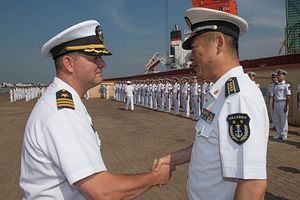U.S. Chief of Naval Operations Admiral John Richardson and his Chinese counterpart Admiral Wu Shengli regularly confer via teleconference to share their views on how the U.S. and Chinese navies are progressing in their military-to-military contacts. Last week, both officials held a two hour conference in which they expressed their satisfaction with a mechanism their two countries established in spring 2014 to prevent miscalculations and unanticipated escalations of encounters at sea. The so-called Code for Unplanned Encounters at Sea (CUES) between the United States and China, among other states, governs communications protocols for naval crews and is a proving to be a useful mechanism between the U.S. and Chinese navies–certainly in the South China Sea.
Wu had originally called CUES a “milestone document” when it was concluded, at the end of the biennial Western Pacific Naval Symposium (WPNS) in Qingdao, China in 2014. CUES was unanimously approved by the 25 participating countries in the 2014 WPNS after having been originally proposed in the early 2000s. (China had originally shown some trepidation over the use of the word “code” in the document’s title, suggesting legal force.) As my colleague Shannon Tiezzi explained at the time, CUES “is a non-binding, voluntary agreement to follow certain set procedures for communicating with other military forces encountered at sea or in the air.”
In retrospect, the timing of the conclusion of CUES was fortuitous. In the months after the 2014 WPNS, the world learned of China’s unilateral artificial island construction activities in the disputed Spratly Islands in the South China Sea, leading to growing tensions in the region over the dispute. This process ultimately culminated with the October 2015 U.S. freedom of navigation patrol in the vicinity of Subi Reef, among other disputed features in the Spratlys. It’s worth noting that despite these tense times in the South China Sea, a major misunderstanding between U.S. and Chinese forces has not taken place. With CUES in place, short of a few dangerous aerial maneuvers by Chinese fighters, we haven’t quite seen incidents at sea similar to USS Cowpens encounter with a People’s Liberation Army-Navy (PLAN) amphibious dock ship. Regarding the issue of unsafe aerial intercepts, the United States and China finalized bilateral rules for aerial encounters as well, building on CUES’ communication protocols.
CUES, of course, is a fairly modest stabilizing mechanism in Asia’s disputed waters. It encourages communication between competing navies, ensuring that intent isn’t misinterpreted. For a look into how the U.S. and Chinese navies interact under CUES, one recalls the USS Lassen‘s Commander Robert Francis’ account to Reuters. Instead of a provocative pass within 500 meters, PLAN crews reached out with a simple inquiry: “‘Hey, you are in Chinese waters. What is your intention?'” Francis continues, revealing the down-to-earth communication taking place between at least some U.S. Navy and PLAN crews:
A few weeks ago we were talking to one of the ships that was accompanying us, a Chinese vessel … [We] picked up the phone and just talked to him like, “Hey, what are you guys doing this Saturday? Oh, we got pizza and wings. What are you guys eating? Oh, we’re doing this. Hey, we’re planning for Halloween as well.”
The intent of all this is valuable both tactically and strategically. On a tactical level, it creates a safer environment for sailors. Francis told Reuters in November 2015 that for his crew, this was a way of showing the PLAN “that we’re normal sailors, just like them, have families, just like them.” On a strategic level, it’s stabilizing to have open channels and established protocols for communications at a time of record-high tensions in the South China Sea. In particular, for the United States, the existence of CUES makes the prospect of increasingly frequent freedom of navigation patrols a more palatable policy option. Asia’s disputed waters grow all the more crowded with time and several states continue to expand their collection of naval assets. Despite high tensions, cordial and clear communication should reduce the odds of miscalculated and unintentional escalation.

































